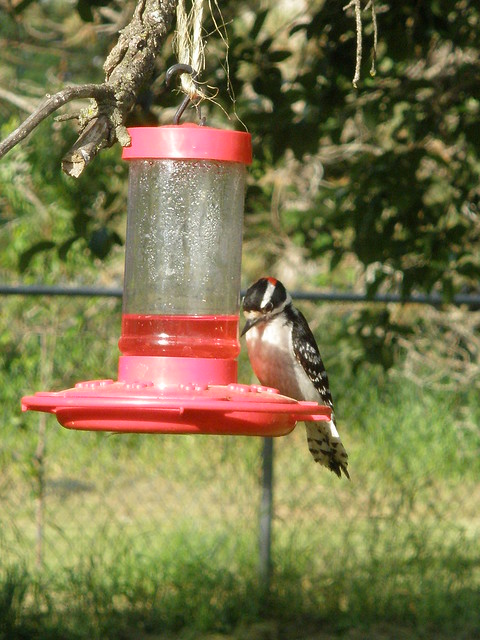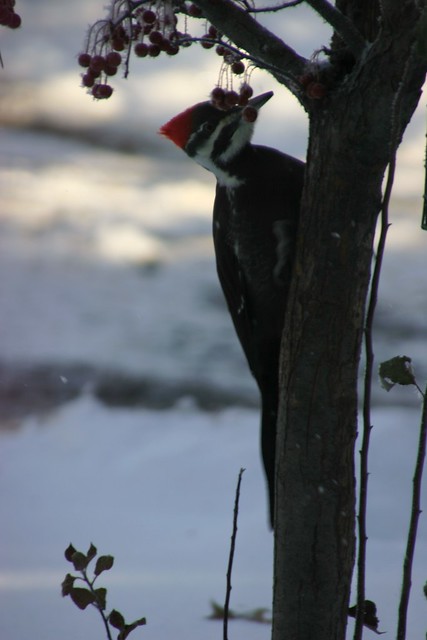For this nature study, we concentrated on woodpeckers. The All About Birds website had some interesting information about downy and pileated woodpeckers which is noted below.
DOWNY WOODPECKERS
Size & Shape
Downy woodpeckers are small versions of the classic woodpecker. They have a straight, chisel-like bill, blocky head, wide shoulders, and straight-backed posture as they lean away from tree limbs and onto their tail feathers. The bill looks smaller for the bird’s size than in other woodpeckers.
Color Pattern
Downy woodpeckers give a checkered black-and-white impression. The black upper-parts are checked with white on the wings, the head is boldly striped, and the back has a broad white stripe down the center.
Males have a small red patch on the back of the head. The outer tail feathers are typically white with a few black spots.
Behavior
Downy woodpeckers move more acrobatically than larger woodpeckers. Their rising-and-falling flight style is distinctive of many woodpeckers. In spring and summer, Downy Woodpeckers make lots of noise, both with their shrill whinnying call and by drumming on trees.
Habitat
You’ll find downy woodpeckers in open woodlands, particularly among deciduous trees, and brushy or weedy edges. They’re also like to be in backyards, orchards, city parks, and vacant lots.
Food
Downy woodpeckers mostly eat insects, including beetle larvae that live inside wood or tree bark as well as ants and caterpillars. They eat pest insects including: tent caterpillars, corn earworm, apple borers, and bark beetles. About a quarter of their diet consists of plant material, particularly grains, acorns, and berries.
Downy woodpeckers are common feeder birds, eating suet and black oil sunflower seeds and occasionally drinking from hummingbird feeders.
This woodpecker visited our hummingbird feeder
daily during the early summer.
June 8, 2011
Nesting
A clutch typically has between 3–8 eggs, with one brood per season. The incubation period is 12 days and nestling period is 18-21 days. The eggs are completely white.
Nest Description
Both male and female downy woodpeckers excavate the nest hole, a job that can take between 1 to 3 weeks. Entrance holes are round and about 1-1.5 inches across. Cavities are 6-12 inches deep and widen toward the bottom to make room for eggs and the incubating bird. The cavity is lined only with wood chips.
Nest Placement Cavity
Downy woodpeckers nest in dead trees or in dead parts of live trees. They typically choose a small stub (averaging around 7 inches in diameter) that leans away from the vertical, and place the entrance hole on the underside.
Nest trees are often deciduous and the wood is more than likely infected with a fungus that softens the wood, making excavating easier.
Sounds
To hear what a downy woodpecker sounds like, click here: Calls
Backyard Tips
Downy woodpeckers enjoy visiting backyard bird feeders. They prefer suet feeders, but are also fond of black oil sunflower seeds, millet, peanuts, and chunky peanut butter. Occasionally, downy woodpeckers will drink from oriole and hummingbird feeders as well.
Interesting Facts
In winter Downy woodpeckers are frequent members of mixed species flocks. Advantages of flocking include: (1) having to spend less time watching out for predators and (2) better luck finding food from having other birds around.
Male and female Downy woodpeckers divide up where they look for food in winter. Males prefer to feed on small branches and weed stems while females prefer larger branches and trunks.
Downy woodpeckers eat food that larger woodpeckers cannot reach, such as insects living on or in the stems of weeds. You may see them hammering at goldenrod galls to extract the fly larvae inside.
Woodpeckers don’t sing songs, but they drum loudly against pieces of wood or metal to achieve the same effect. People sometimes think this drumming is part of the woodpeckers' feeding habits, but it isn’t. In fact, feeding birds make very little noise even when they’re digging into wood.
PILEATED WOODPECKER
The nest holes these birds make offer crucial shelter to many species including swifts, owls, ducks, bats, and pine martens.
Size & Shape
The pileated woodpecker is one of the biggest, most striking forest birds on the continent. Nearly the size of a crow, it has black with bold white stripes down its long neck and a flaming-red triangular crest that sweeps off the back of the head.
Pileated woodpecker on our plum tree.
December 12, 2007.
The bill is long and chisel-like, about the length of the head. In flight, the wings are broad and the bird can seem crowlike.
Color Pattern
Pileated woodpeckers are mostly black with white stripes on the face and neck; and have a flaming-red crest. Males have a red stripe on the cheek. In flight, the bird reveals extensive white underwings and small white crescents on the upper side, at the bases of the primaries.
Within an hour of putting out new feeders,
this woodpecker and others found it.
This one is on our pear tree.
November 11, 2007.
Behavior
Pileated woodpeckers drill distinctive rectangular-shaped holes in rotten wood to get at carpenter ants (their main prey) and other insects. They are loud birds with whinnying calls. They also drum on dead trees in a deep, slow, rolling pattern, and even the heavy chopping sound of foraging carries well. Their flight undulates like other woodpeckers, which helps separate them from a crow’s straight flight path.
Food
In addition to carpenter ants, pileated woodpeckers also eat other types of ants, termites, woodboring beetle larvae, and other insects such as flies, caterpillars, cockroaches, spruce budworm, and grasshoppers. They also eat nuts and wild fruits, including hackberry, sassafrass, greenbrier, blackberries, poison ivy, holly, dogwood, sumac berries, persimmon, and elderberry.
In some diet studies, ants constituted 40 percent of a pileated woodpecker's diet, and up to 97 percent in some individuals. Occasionally, pileated woodpeckers visit backyard bird feeders for seeds or suet.
Habitat
Pileated woodpeckers are forest birds that require large, standing dead trees and downed wood. Forests can be evergreen, deciduous, or mixed. In the East (including Minnesota) they live in both old and young forests and may even be seen in partially-wooded suburbs and backyards.
Interesting Facts
The pileated woodpecker digs characteristically rectangular holes in trees to find ants. These excavations can be so broad and deep that they can cause small trees to break in half.
A pileated woodpecker pair stays together in its territory all year round. It will defend the territory in all seasons, but will tolerate new arrivals during the winter.
Nesting
The clutch size is 3–5 eggs; and one brood per season is common. The incubation period is 15-18 days, and the nesting period is 24-28 days. The eggs are white.
Nest Description
The male begins excavating then nest cavity and does most of the work, but the female contributes, particularly as the hole nears completion. The entrance hole is oblong rather than the circular shape of most woodpecker holes.
The girls outside braving the 0 degree weather.
They are standing next to woodpecker's holes in the tree.
February 8, 2011
For the finishing touches, the bird climbs all the way into the hole and chips away at it from the inside. Periodically the adult picks up several chips at a time in its bill and tosses them from the cavity entrance.
Pileated woodpeckers do not line their nests with any material except for leftover wood chips. The nest construction can take between 3-6 weeks, and nests are rarely reused in later years. Cavity depth can range from 10-24 inches.
Nest Placement
Nest trees are typically dead and within a mature or old stand of coniferous or deciduous trees, but may also be in dead trees in younger forests or even in cities. Dead trees are a valuable resource as nest sites or shelter for birds and other animals, and pileated woodpeckers battle for ownership with European starlings, wood ducks, red-headed woodpeckers, red-bellied woodpeckers, Eastern bluebirds, and great crested flycatchers. Occasionally bats and swifts share roost cavities with pileated woodpeckers.
Sounds
To hear what a pileated woodpeckers sound like, click here: Sound.
*~*~*~*~*~*~*~*~*~*
In addition to learning about woodpeckers, we studied a bit about birds' feet as noted on pages 40-42 of The Handbook of Nature Study. We also visited a website that looked at different types of bird feet.
“The feet of birds are shaped so as to assist the bird to get its food as well as for locomotion.”
~ The Handbook of Nature Study, page 41 ~
This week during our outdoor time, we actually spent time watching the birds that came to the feeder so we could get a better look at their feet.
After doing that, we went outdoors to see what birds we could observe.
Woodpeckers that We've Observed in the Past
Red-bellied woodpecker in the pine tree.
September 21, 2012.
Red-bellied woodpecker drinking nectar
from the hummingbird feeder.
For at least a few weeks, this bird would visit the feeder daily
(sometimes more than once a day.)
It would always announce its arrival with a loud call.
It was such a joy to see it each day.
September 14, 2012.
This was a northern flicker that was in the backyard.
September 21, 2012.
These two northern flickers were hanging out with
a robin that was on the bird bath.
September 21, 2012.
Nature Journal Entry
The girls each did a nature journal entry. Olivia used pictures she found from the internet as starting points for her journal page.
Sophia researched different facts and drew pictures to illustrate what she learned.
It's interesting to see the different styles of journaling take shape as the girls get older.
We used the Outdoor Hour Challenge Autumn Series - Woodpeckers as inspiration.












No comments:
Post a Comment
Thanks for taking time to read my blog and share your comments. Have a great day!